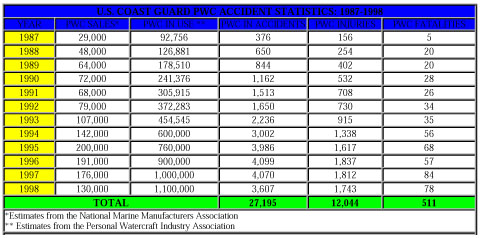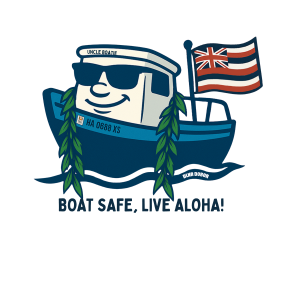Personal Watercraft Safety
PERSONAL WATERCRAFT SAFETY
The increased sales and marketing of Personal Watercraft (PWC), particularly over the past several years, has resulted in significant increases in the number of these craft on the water. Along with this growth has come an unfortunate increase in the number of PWC-related accidents tracked by the states and reported to the U.S. Coast Guard (see table below ). It has been easy for critics of PWC to see this as evidence of a safety concern with these craft. While these “raw number” approaches are understandable, they tell only part of the story.

About 11 percent of all registered boats nationwide are personal watercraft. Industry statistics show that although PWC owners typically have substantial boating experience, they share their vessel with an average of three different people on a typical boating day.
“Without a doubt an educated boater is a safe boater,” states Larry Lambrose, executive director of the Personal Watercraft Industry Association (PWIA). “The personal watercraft industry strongly supports mandatory education for all boaters and the use of personal flotation devices for all passengers and boat operators. In fact, we have provisions for both in our model law and are encouraged that states are seeing such positive results from the legislation.”
More than twenty-six states have based PWC laws on the PWC Model Safety Act developed and endorsed by the National Association of State Boating Law Administrators (NASBLA). This act addresses minimum operator age (sixteen), prohibits nighttime and reckless operation, requires all operators and passengers to wear U.S. Coast Guard approved life jackets, and requires operators to use the lanyard stop switch (for boats so equipped).
Accident statistics have identified items to be addressed through a combination of education, public awareness and possible manufacturing changes. Some of these items include better understanding of the operator’s responsibility by some PWC riders, especially renters and nonowner operators. The “tunnel vision” syndrome when the rider fails to look around before turning. Another major concern is “off-throttle steering” accidents that result in the need to use the throttle to turn the machine away from danger.
Laws are being enforced to address unsafe operating patterns such as reckless operation, which includes wake jumping too close behind larger vessels. Education has been mandated in several states to require completion of a boater education course prior to operation.
- Connecticut implemented mandatory education in 1993 for most boaters and all PWC operators. Since then, there have been no PWC-related fatalities. And although the number of registered PWC has grown by 36 percent, the number of accidents has not increased.
- Utah’s mandatory education law applies to operators 12-17 and was implemented in 1995. Since 1996, registrations have increased 20 percent and accidents involving 12-15 year olds have dropped by 57 percent.
- Florida established mandatory education in 1996 and since then, accidents in the 16 and under age group decreased almost 50 percent. Additionally, injuries have dropped 15 percent and fatalities have dropped 33 percent.
There is more to know about personal watercraft operation. Continued vigilance and attention to the lessons learned from past accidents will help ensure the safe growth of this popular and enjoyable form of boating.
For more information about personal watercraft safety or other issues, visit the PWIA website at www.pwia.org
Other pertinent information about PWCs and water safety in the DOBOR web site:
Life Vests… They Float, You Don’t
BOAT SMART FROM THE START… KNOW BEFORE YOU GO!!!
